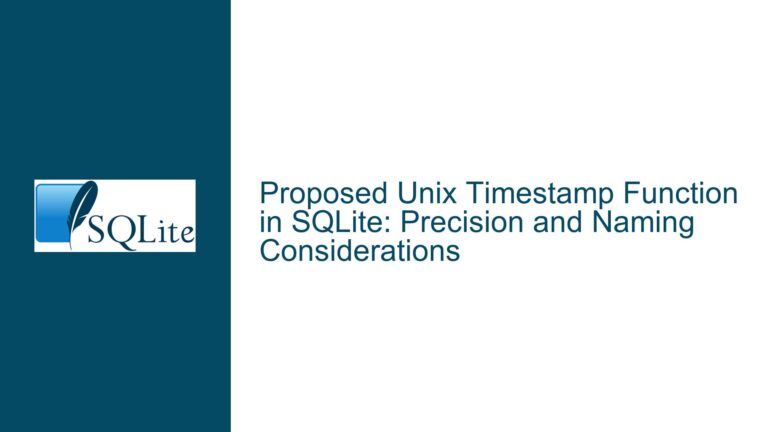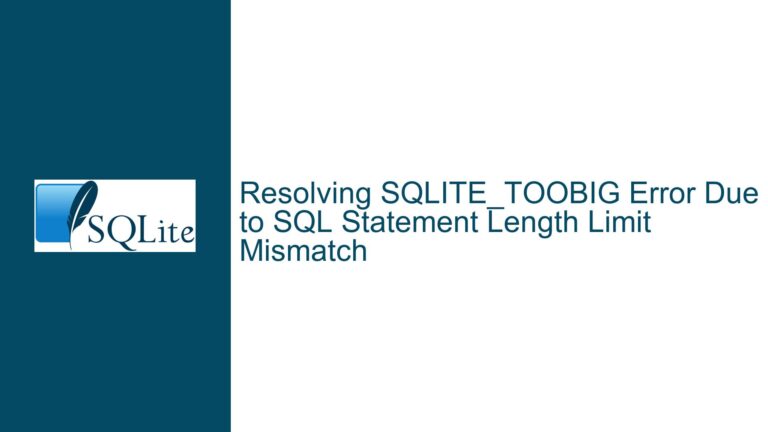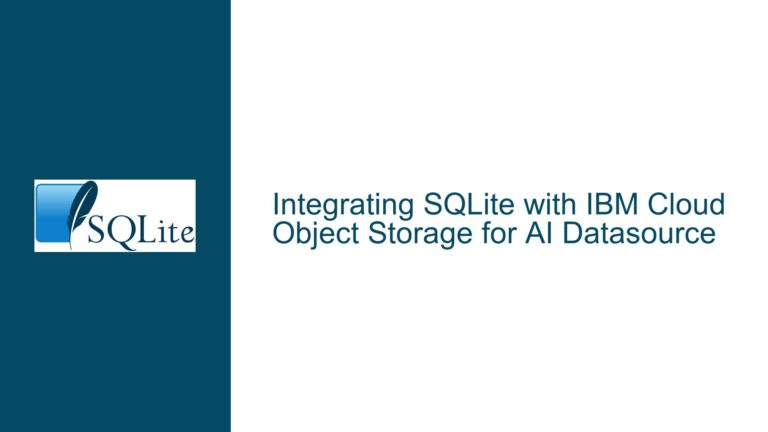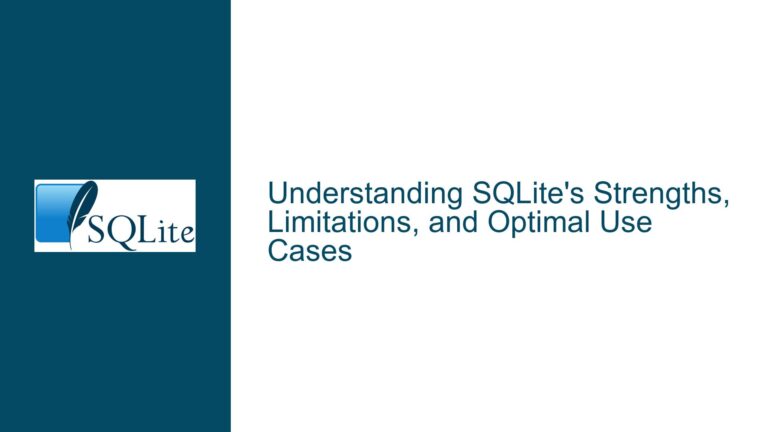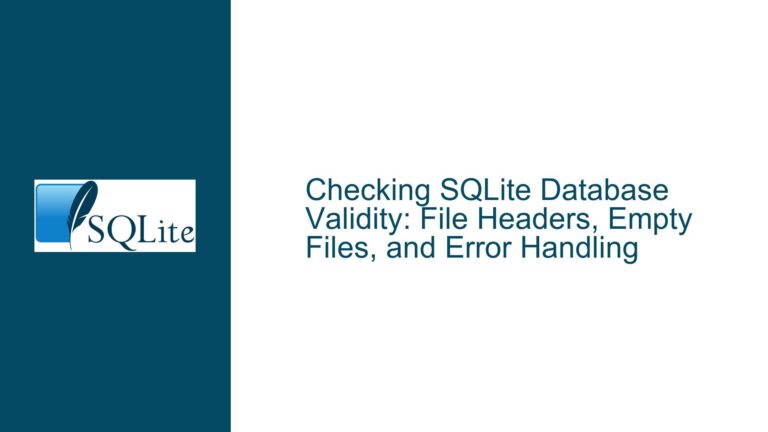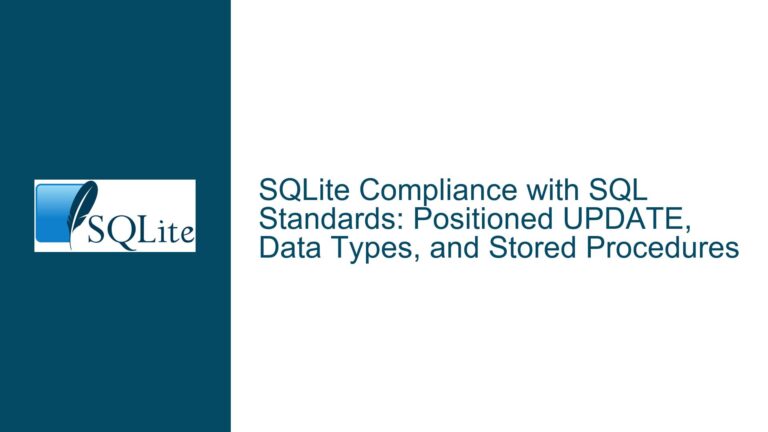Handling BLOB Data in SQLite Using C: Insertion and Extraction Techniques
Storing and Retrieving Binary Data in SQLite Using BLOBs
When working with SQLite in a C program, one common requirement is the storage and retrieval of binary data, such as images, using Binary Large Objects (BLOBs). BLOBs allow for the storage of raw binary data directly within the database, which can be particularly useful for applications that need to manage multimedia files, serialized objects, or other binary formats. However, handling BLOBs in SQLite using C requires a clear understanding of the SQLite C API, particularly the functions designed for binding and extracting binary data.
The process involves two main operations: inserting binary data into a BLOB column and extracting binary data from a BLOB column. Both operations require careful handling of memory and the use of specific SQLite C API functions. Below, we will explore the nuances of these operations, including the potential pitfalls and best practices for ensuring efficient and error-free handling of BLOBs.
Challenges with Binary Data Binding and Extraction
One of the primary challenges when working with BLOBs in SQLite using C is the correct binding of binary data to SQL statements and the subsequent extraction of that data. Unlike text or numeric data, binary data does not have a natural termination character (like the null terminator in strings), which means that the size of the data must be explicitly managed. This requirement introduces complexity, particularly when dealing with dynamic data sizes or when the binary data is generated or consumed on-the-fly.
Another challenge is the efficient streaming of binary data into and out of the database. For large binary objects, loading the entire data into memory before insertion or after extraction can be impractical due to memory constraints. SQLite provides a streaming interface for BLOBs, but using this interface correctly requires a deep understanding of how SQLite manages BLOB handles and how to ensure that these handles are properly opened, read, written, and closed.
Implementing BLOB Handling with SQLite C API
To effectively handle BLOBs in SQLite using C, you need to use the sqlite3_bind_blob function for inserting binary data and the sqlite3_column_blob function for retrieving it. These functions are part of the SQLite C API and are designed to handle binary data in a way that is both efficient and safe.
Inserting Binary Data into a BLOB Column
To insert binary data into a BLOB column, you first need to prepare an SQL INSERT statement that includes a placeholder for the BLOB data. This placeholder is typically represented by a question mark (?) in the SQL statement. Once the statement is prepared, you can bind the binary data to this placeholder using the sqlite3_bind_blob function.
The sqlite3_bind_blob function requires four parameters: the prepared statement object, the index of the placeholder (starting from 1), a pointer to the binary data, the size of the binary data in bytes, and a destructor function that SQLite will call to free the memory after the data has been inserted. If you want SQLite to manage the memory, you can pass SQLITE_STATIC as the destructor, which tells SQLite that the data is static and should not be freed. Alternatively, if you want SQLite to make a copy of the data and manage its memory, you can pass SQLITE_TRANSIENT.
Here is an example of how to insert binary data into a BLOB column:
sqlite3_stmt *stmt;
const char *sql = "INSERT INTO test_table (data_column) VALUES (?);";
int rc = sqlite3_prepare_v2(db, sql, -1, &stmt, NULL);
if (rc != SQLITE_OK) {
// Handle error
}
// Assuming 'binary_data' is a pointer to the binary data and 'data_size' is its size in bytes
rc = sqlite3_bind_blob(stmt, 1, binary_data, data_size, SQLITE_STATIC);
if (rc != SQLITE_OK) {
// Handle error
}
rc = sqlite3_step(stmt);
if (rc != SQLITE_DONE) {
// Handle error
}
sqlite3_finalize(stmt);
Extracting Binary Data from a BLOB Column
To extract binary data from a BLOB column, you need to prepare an SQL SELECT statement that retrieves the BLOB data. Once the statement is executed, you can use the sqlite3_column_blob function to access the binary data. This function returns a pointer to the binary data, and you can use the sqlite3_column_bytes function to determine the size of the data.
Here is an example of how to extract binary data from a BLOB column:
sqlite3_stmt *stmt;
const char *sql = "SELECT data_column FROM test_table WHERE id = ?;";
int rc = sqlite3_prepare_v2(db, sql, -1, &stmt, NULL);
if (rc != SQLITE_OK) {
// Handle error
}
// Assuming 'row_id' is the ID of the row you want to retrieve
rc = sqlite3_bind_int(stmt, 1, row_id);
if (rc != SQLITE_OK) {
// Handle error
}
rc = sqlite3_step(stmt);
if (rc == SQLITE_ROW) {
const void *blob_data = sqlite3_column_blob(stmt, 0);
int blob_size = sqlite3_column_bytes(stmt, 0);
// Now you can use blob_data and blob_size as needed
} else {
// Handle error or no data found
}
sqlite3_finalize(stmt);
Streaming Binary Data Using SQLite BLOB Handles
For large binary objects, it may be more efficient to use SQLite’s BLOB streaming interface, which allows you to read from or write to a BLOB incrementally. This interface is accessed through the sqlite3_blob_open, sqlite3_blob_read, sqlite3_blob_write, and sqlite3_blob_close functions.
To use this interface, you first need to open a BLOB handle using sqlite3_blob_open. This function requires the database connection, the name of the table, the name of the BLOB column, the row ID, and a flag indicating whether the BLOB should be opened for reading or writing. Once the BLOB handle is opened, you can use sqlite3_blob_read to read data from the BLOB or sqlite3_blob_write to write data to the BLOB. Finally, you should close the BLOB handle using sqlite3_blob_close.
Here is an example of how to use the BLOB streaming interface to read data from a BLOB:
sqlite3_blob *blob_handle;
int rc = sqlite3_blob_open(db, "main", "test_table", "data_column", row_id, 0, &blob_handle);
if (rc != SQLITE_OK) {
// Handle error
}
// Assuming 'buffer' is a buffer to hold the data and 'buffer_size' is its size
rc = sqlite3_blob_read(blob_handle, buffer, buffer_size, 0);
if (rc != SQLITE_OK) {
// Handle error
}
sqlite3_blob_close(blob_handle);
Similarly, here is an example of how to use the BLOB streaming interface to write data to a BLOB:
sqlite3_blob *blob_handle;
int rc = sqlite3_blob_open(db, "main", "test_table", "data_column", row_id, 1, &blob_handle);
if (rc != SQLITE_OK) {
// Handle error
}
// Assuming 'buffer' is a buffer containing the data and 'buffer_size' is its size
rc = sqlite3_blob_write(blob_handle, buffer, buffer_size, 0);
if (rc != SQLITE_OK) {
// Handle error
}
sqlite3_blob_close(blob_handle);
Best Practices for Handling BLOBs in SQLite
When working with BLOBs in SQLite, it is important to follow best practices to ensure that your application is efficient, reliable, and secure. Here are some key considerations:
Memory Management: Be mindful of memory usage, especially when dealing with large BLOBs. Use the streaming interface for large objects to avoid loading the entire BLOB into memory at once.
Error Handling: Always check the return codes of SQLite functions and handle errors appropriately. This is particularly important when working with BLOBs, as errors can lead to data corruption or memory leaks.
Transaction Management: Use transactions to ensure that your BLOB operations are atomic. This is especially important when performing multiple related operations, such as inserting or updating multiple BLOBs.
Security: Be cautious when handling binary data from untrusted sources. Validate the data to ensure that it is in the expected format and does not contain malicious content.
Performance: Consider the performance implications of your BLOB operations. For example, avoid frequent small writes to a BLOB, as this can lead to fragmentation and reduced performance. Instead, try to write larger chunks of data at once.
By following these best practices and using the SQLite C API correctly, you can effectively manage BLOBs in your C applications, ensuring that your data is stored and retrieved efficiently and securely.

